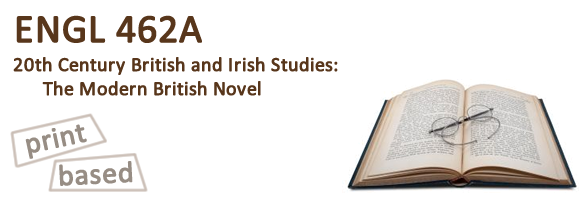
Mode of Delivery
This is a print-based, correspondence course.
Course Outline
- Four assignments
- Final examination
Course Description
This course examines developments in the novel up to the Second World War.
Intended Student and Prerequisites
The audience for this course consists primarily of people with an interest in modern literature who are working towards the Bachelor’s degree. These will primarily be students in the English Major, but the course need not be confined to them alone. Because of the contextual approach to the novels, students majoring in disciplines adjacent to literary studies will also benefit. Students in history, philosophy, psychology, sociology, and the fine arts will find much of interest in the literature the course will examine.
The course will also appeal to teachers in the process of updating their qualifications. Of particular usefulness is the course’s focus. It will agree well with curricular changes that emphasize inter-disciplinarity and contextual approaches.
Prerequisites:
Six credits of first-year English and third-year standing.
Course Objectives
When you have completed English 462A, you should be familiar:
- with the principal developments in the evolution of the British novel in the first half of the twentieth century;
- with individual works of major novelists in the period;
- with the crucial intellectual and cultural changes of early twentieth-century Britain as these changes are represented and appraised in the fiction; and
- with methods of critical reading that reflect recent developments in literary theory and cultural studies.
Course Overview
The course begins in Lesson One with a consideration of Joseph Conrad’s The Secret Agent (1907), one of the sequence of novels that run from Lord Jim (1900) to Victory (1915) that constitutes the core of Conrad’s achievement. The main purpose of this lesson is to provide a bridge between ‘the great tradition’ of Victorian realism and the new impulses of the early twentieth century.
Lesson Two takes up James Joyce’s Portrait of the Artist as a Young Man (1916) and introduces us to the beginnings of modernism as a literary movement and as a response to the new conditions of existence in modern times. Matters of form (the Bildungsroman), language, the formation of identity, and voice are central to our reading of the text.
Art, aestheticism, the cultural role of the artist, and the inter-relationship among the arts in modernism provide the wider critical framework for our reading of Wyndham Lewis’s satiric novel Tarr (1918, 1928) in Lesson Three.
Lesson Four directs our attention to a third current in modernism. D. H. Lawrence’s Women in Love (1921) attempts to reconcile the clash of the inward and the external, that is, the contrasting currents of early modernism.
The study of E. M. Forster’s A Passage to India (1924) in Lesson Five gives us the opportunity to take stock of the modernist ideas we have been pursuing up to this point.
Lesson Six completes our study of the modernist revolution by examining one of the most accomplished examples of modernist art in the late 1920s, Virginia Woolf’s To the Lighthouse (1927).
Graham Greene’s Brighton Rock, the subject of Lesson Seven, typifies very well the new mood in the fiction of the 1930s: despairing, unsentimental, abstemious, and morally supine. The lesson gives us a chance to delineate the character of the new realism.
The appetite for a new realism in content and form also marks the concluding work in the course, Elizabeth Bowen’s powerful novel of wartime London, The Heat of the Day, in Lesson Eight. This is a forceful novel in terms of verbal style, theme, characterization and narrative cogency.
Evaluation
The course grade for English 462A consists of the following:
| Essays (4 x 20) | 80 |
| Final Exam | 20 |
| Total | 100 |
Textbooks – ENGL462A Textbook Order Form
- Joseph Conrad, The Secret Agent. Penguin, 1907.
- James Joyce, Portrait of the Artist as a Young Man, Penguin, 1916.
- ENGL 462A Customs Course Materials. Reprint of: Wyndham Lewis, Tarr, Penguin, 1918, 1928.
- D. H. Lawrence, Women in Love, Penguin, 1921.
- E. M. Forster, A Passage to India, Penguin, 1924.
- Virginia Woolf, To the Lighthouse, Penguin, 1927.
- Graham Greene, Brighton Rock, Penguin, 1938.
- Elizabeth Bowen, The Heat of the Day, Anchor, 2002.
Also required:
- ENGL 462A Learner Package (includes the course manual)
